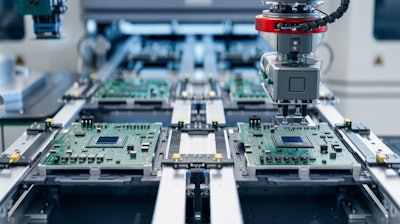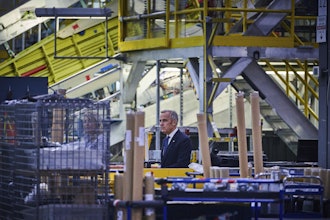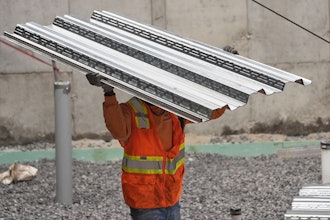
TEMPE, Ariz. — Economic activity in the manufacturing sector expanded in March after contracting for 16 consecutive months, say the nation's supply executives in the latest Manufacturing ISM Report On Business.
The report was issued Monday by Timothy R. Fiore, CPSM, C.P.M., chair of the Institute for Supply Management Manufacturing Business Survey Committee:
"The Manufacturing PMI registered 50.3 percent in March, up 2.5 percentage points from the 47.8 percent recorded in February. The overall economy continued in expansion for the 47th month after one month of contraction in April 2020. (A Manufacturing PMI® above 42.5 percent, over a period of time, generally indicates an expansion of the overall economy.) The New Orders Index moved back into expansion territory at 51.4 percent, 2.2 percentage points higher than the 49.2 percent recorded in February. The March reading of the Production Index (54.6 percent) is 6.2 percentage points higher than February's figure of 48.4 percent. The Prices Index registered 55.8 percent, up 3.3 percentage points compared to the reading of 52.5 percent in February. The Backlog of Orders Index registered 46.3 percent, the same reading as in February. The Employment Index registered 47.4 percent, up 1.5 percentage points from February's figure of 45.9 percent.
"The Supplier Deliveries Index figure of 49.9 percent is 0.2 percentage point lower than the 50.1 percent recorded in February. (Supplier Deliveries is the only ISM® Report On Business® index that is inversed; a reading of above 50 percent indicates slower deliveries, which is typical as the economy improves and customer demand increases.) The Inventories Index increased 2.9 percentage points to 48.2 percent following a reading of 45.3 percent in February.
"The New Export Orders Index reading of 51.6 percent is the same reading as registered in February. The Imports Index continued in expansion territory, registering 53 percent, the same figure as in February. Both indexes repeated their highest readings since July 2022, when the New Export Orders Index registered 52.6 percent and the Imports Index registered 54.4 percent."
"The U.S. manufacturing sector moved into expansion for the first time since September 2022. Demand was positive, output strengthened and inputs remained accommodative. Demand improvement was reflected by the (1) New Orders Index back in expansion and fewer comments regarding 'softening,' (2) New Export Orders Index expanding again, supported by panelists' stronger optimism (3) Backlog of Orders Index remaining in moderate contraction territory, the same as in February and (4) Customers' Inventories Index contracting for the fourth consecutive month, remaining at a level accommodative for future production. Output (measured by the Production and Employment indexes) surged, with a combined 7.7-percentage point upward impact on the Manufacturing PMI calculation. Panelists' companies notably increased their production levels month over month. Head-count reductions continued in March, with sizable layoff activity reported. Inputs — defined as supplier deliveries, inventories, prices and imports — continued to accommodate future demand growth and showed signs of stiffening. The Supplier Deliveries Index dropped marginally, moving into 'faster' territory, and the Inventories Index improved but remained in slight contraction territory. The Prices Index moved further upward in moderate expansion (or 'increasing') territory as commodity driven costs remain unstable.
"Of the six biggest manufacturing industries, four — Food, Beverage & Tobacco Products; Fabricated Metal Products; Chemical Products; and Transportation Equipment, which account for a combined 54 percent of manufacturing gross domestic product (GDP) — registered growth in March.
"Demand remains at the early stages of recovery, with clear signs of improving conditions. Production execution surged compared to January and February, as panelists' companies reenter expansion. Suppliers continue to have capacity but are showing signs of struggling, due in large part to their raw material supply chains. Thirty percent of manufacturing GDP contracted in March, down from 40 percent in February. More importantly, the share of sector GDP registering a composite PMI® calculation at or below 45 percent — a good barometer of overall manufacturing weakness — was 1 percent in March, the same as in February, but categorically healthier than the 27 percent recorded in January. Among the top six industries by contribution to manufacturing GDP in March, none had a PMI at or below 45 percent."
The nine manufacturing industries reporting growth in March — in order — are: Textile Mills; Nonmetallic Mineral Products; Paper Products; Petroleum & Coal Products; Primary Metals; Food, Beverage & Tobacco Products; Fabricated Metal Products; Chemical Products; and Transportation Equipment. The six industries reporting contraction in March — in the following order — are: Furniture & Related Products; Plastics & Rubber Products; Electrical Equipment, Appliances & Components; Machinery; Computer & Electronic Products; and Miscellaneous Manufacturing.
WHAT RESPONDENTS ARE SAYING
- "Performance continues to defy projections of a downturn in activity. Demand remains strong, and the pipeline for orders is robust." [Chemical Products]
- "Expecting to see orders and production pick up for the second quarter. Suppliers are working with us to help drive costs down, which will help improve the margin for the rest of the year and deliver growth in 2025." [Transportation Equipment]
- "Commodity prices continue to hold steady." [Food, Beverage & Tobacco Products]
- "Demand remains soft, but optimism is high that orders are 'just on the horizon.' Expectations are for a strong second quarter. Supply chain issues are minimal, with only semiconductors and select electronic parts being an issue." [Computer & Electronic Products]
- "Noticing an increase in suppliers' selectiveness regarding orders they quote and take. Additionally, there's been a noticeable increase in manufacturing companies targeted for acquisition by larger entities (established companies, investment firms and the like)." [Machinery]
- "Business is still strong — we are meeting and exceeding our forecasts. So far, we're not hearing anything negative with our customers as far as ongoing business is concerned — it's the same for raw material suppliers, nothing negative." [Fabricated Metal Products]
- "As an energy-intensive manufacturer, energy pricing continues to be a concern for our business. The move to electrification has increased demand, and supply is not stable because we're not in an ideal geography for wind and solar power." [Paper Products]
- "The potential aftermaths of the presidential election are beginning to impact conversations and negotiations of long-term agreements/contracts." [Petroleum & Coal Products]
- "Continue to experience a softness in the industrial sector. There is optimism that order activity will increase in the late second quarter, leading to improvement in this segment for the second half of the year. The aerospace and defense market is continuing to ramp up, and demand is outpacing supply in our supply chain." [Primary Metals]
- "Business activity is up. Many manufacturers are anticipating better business in the second quarter and much better in the third quarter. They are reporting that second-quarter bookings are just starting to ramp up." [Wood Products]






















